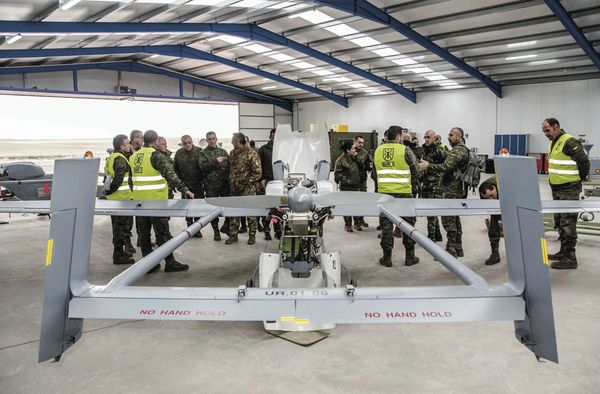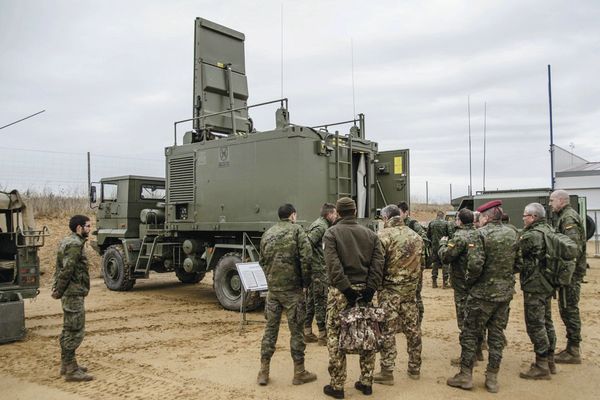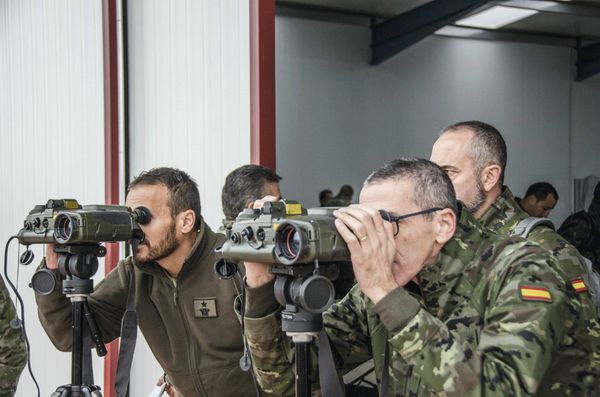- Home
- Feature Articles
- Los medios de inteligencia, más unidos que nunca
INTEL, closer than ever
Tuesday, January 17, 2017
Number: 29
At the end of Nov., at the "Pajares de los Oteros" airbase in Leon, Spain, the session on the ISTAR integration gathered different Spanish Army units. ISTAR stands for: Information, Surveillance, Task Acquisition, and Reconnaissance. Nearby, we find the GROSA group: Group of obtention/gathering via air systems from the RINT n. 1 Intelligence Regiment that is in charge of performing the flying campaign of the remote piloted air system or RPAS or PASI (from the Spanish: Platform Air System of Intel).
The different units brought to the occasion both; ISTAR obtention means, and communication and information systems (CIS). Therefore, the CIS involved were one Nodo C2 SIMACET (Spanish for: Info Sys for Command and Control of the Spanish Army), another Nodo SAPIIEM reduced (service, support and interoperability ISR —Information, Surveillance, Reconnaissance— military from Spain) made up of a Coalition Sharing Database, two SAPIIEM/Seism Multi-intel exploitation systems, four radios AN/PRC-117G an data diode to warrant the transfer of information between both sefety and security domains of different level.

GROSA personnel talking about PASI Systems (Photo: High Readiness Force Land Headquarters)
Sumary: A successful session thanks to the involved participating units
Also, the deployed sensors and systems ISTAR were the following: RPAS/PASI Systems (brought there by GROSA of the RINT 1), a VERT, or vehicle of land exploration (brought there by the Spanish Cavalry Regiment n.11), two Coral cameras (brought there by the 7th 'Galicia' Brigade), and the Arthur and Halo Systems (brought by the Artillery Group of information and localization from the n.63 Artillery Regiment Missile Campaign).
The previous CIS planning and readiness phase took place days before with military personnel and IT means drom the Signal Regiment n. 21 for the implementation of signals (video/images flow and metadata) coming from different ISTAR with the system that receives and exploit them. Participating with technical support, there was the GMV Company which is in charge of Research and Development of the JISR SAPIIEM system .
One of the aims achieved on this session was to check and progress the system´s operability between the ISR systems and the JISR SAPIIEM system. Another aim was to teach, even more, the personnel from the Spanish GCTAD (High Readiness of the land HQ´s Intel Section) about the capabilities to obtain ISR from specific equipments and ISTAR systems of the Spanish Army. The teaching ends with the training of the JISR SAPIIEM operators´ personnel since SAPIIEM/Earthquake operators could have again contact with the system and refresh theory and practice knowledge on this tool.
To wrap up, this session means a new progress in the total integration of images and metadata flows that generated by the ISTAR sensors at the Spanish Army within the system JISR SAPIIEM and its last exploitation in the SAPIIEM/Earthquake system. .
We hope this session to be the seed of future sessions which include the highest posible number of participants and of gathering systems.

GAIL members talk about the acquisition radar of Arthur tasks. (Photo: Spanish CGTAD)
SUPPORT
THE CAVALRY BRIGADE ASSESS THE FULMAR RPAS
The Cavalry Brigade, on its part, has assesed the FULMAR Type I RPAS (remote pilot air system) that the Company Thales is developing and it seems it will be the new air means to get info Brigade type. For that, a flying campaing has been done from Nov., 23-25 at “San Gregorio” (Zaragoza) training center. This campaign has been designed to integrate the FULMAR aircraft model within a tactical exercise. This has included day and night exercises focused on possible missions the system would carry out in military missions.

Thermical Camera 'Coral' is used by CGTAD Intel Section (Foto: CGTAD)
ARMY UNITS
- Araba Álava |
- Albacete |
- Alicante |
- Almería |
- Asturias |
- Ávila |
- Badajoz |
- Barcelona |
- Burgos |
- Cáceres |
- Cádiz |
- Cantabria |
- Castellón |
- Ceuta |
- Ciudad Real |
- Córdoba |
- A Coruña |
- Cuenca |
- Girona |
- Granada |
- Guadalajara |
- Gipuzkoa |
- Huelva |
- Huesca |
- Islas Baleares |
- Jaén |
- León |
- Lleida |
- Lugo |
- Madrid |
- Málaga |
- Melilla |
- Murcia |
- Navarra |
- Ourense |
- Palencia |
- Las Palmas |
- Pontevedra |
- La Rioja |
- Salamanca |
- Segovia |
- Sevilla |
- Soria |
- Tarragona |
- Santa Cruz de Tenerife |
- Teruel |
- Toledo |
- Valencia |
- Valladolid |
- Bizkaia |
- Zamora |
- Zaragoza



